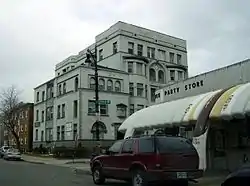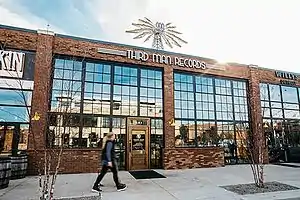Cass Corridor
The Cass Corridor is the name of the neighborhoods on the west end of Midtown Detroit, Michigan. It includes the Cass Park Historic District, the Cass-Davenport Historic District and Old Chinatown. The corridor's main street, Cass Avenue, runs parallel with M-1 (Woodward Avenue), a main Detroit artery running north toward New Center. Though Cass runs from Congress Street, ending a few miles farther north at West Grand Boulevard, the Cass Corridor generally is defined as between Interstate 75 (I-75) at its southern end and Interstate 94 (I-94) to the north, and stretches from Woodward to the east and to the west: John C. Lodge (M-10 service drive) north of Temple, and Grand River Avenue south of Temple.
Cass Corridor, Detroit | |
|---|---|
Neighborhood of Detroit | |
| Cass Corridor | |
 Corner of Cass and Ferry, showing the Verona Apartments. | |
| Coordinates: 42°21′48″N 83°04′13″W | |
| Country | |
| State | |
| County | |
| City | |
| Area | |
| • Total | 0.9 km2 (0.36 sq mi) |
| • Land | 0.9 km2 (0.36 sq mi) |
| • Water | 0 km2 (0.0 sq mi) |
| Population (2010) | |
| • Total | 1,707 |
| Time zone | UTC-5 (Eastern Standard Time (North America)) |
| • Summer (DST) | UTC-4 (Eastern Daylight Time (North America)) |
History

Significant landmarks of the area include the Detroit Masonic Temple (the world's largest building of its kind),[2] Cass Technical High School, and the Metropolitan Center for High Technology are all located along Cass. Little Caesars Arena, open since September 5, 2017 as the new home of the NHL's Detroit Red Wings and the NBA's Detroit Pistons, is on the west side of Woodward Avenue near I-75.
In the 1960s and '70s, the Cass Corridor became an area of cultural significance. Artists began renting cheap studio space in the Cass Corridor, which was near Detroit's Cultural Center Historic District. Artists associated with or influenced by the Cass Corridor artist movement include Brenda Goodman, Gary Grimshaw, Tyree Guyton, Charles McGee, Ann Mikolowski, Jim Pallas, Ellen Phelan, Gilda Snowden, Robert Wilbert, and Theo Wujcik.[3]
In the 1970s, the Cass Corridor was a poor neighborhood known for drugs, prostitution and sex crimes against children. The area was of significance in the Oakland County Child Killer case.[4][5]
Creem, which billed itself as "America's Only Rock 'n' Roll Magazine," had its headquarters in the area. The student population contributes to the bohemian atmosphere in Cass Corridor. The artistic community has produced a number of significant artists, including Sixto Rodriguez, Negative Approach and The White Stripes, who played their first show at the Gold Dollar.[6] Cass Corridor is also the location of the annual Dally in the Alley arts festival.[7]
Since the 2000s, Joel Landy, president of the Cass Avenue Development construction company, has renovated and remodelled several buildings in the Cass Corridor.[8] Landy was also featured in the television series American Pickers[9] (season 3 episode "Motor City", 19 September 2011). Since 1997, Avalon International Breads has been located in the Cass Corridor.[10] In 2015, Jack White of the White Stripes, opened a retail store for his Record Label, Third Man Records at the Corner of Canfield and Cass.[11]
From 2009, Dr. Alesia Montgomery of Michigan State University conducted a 5-year study visualizing a reinvented Detroit as a green city, with a particular emphasis on the Cass Corridor.[12][13]
References
- Third Man Records - Detroit Storefront
- "Masonic Temple Of Detroit- History". Archived from the original on 2008-05-14. Retrieved 2008-07-08.
- Mikolowski, Ken (2009). Gonzalez, Lisa Baylis; Schemske, Sandra (eds.). "Time and Place: of Detroit's Cass Corridor from the Wayne State University Collection. Exhibition Catalogue, Elaine L. Jacob Gallery, April 24–June 26, 2009" (PDF). Detroit, MI: College of Fine, Performing, and Communication Arts. Wayne State University.
One of the advantages of living in post-riot Detroit was the wide availability of big, cheap space. Artists quickly found buildings for studios all along the Cass Corridor. Visiting those studios in the Vernor's building or Common Ground or a bit later, the Forsythe building, you would come across the artists making their art with found objects from the streets of Detroit.
- "On the Trail of the Oakland County Child Killer". Retrieved 2019-05-26.
- "Oakland county child killer -- case-background". Retrieved 2019-06-01.
- Sullivan, Denise (March 1, 2004). The White Stripes: Sweethearts of the Blues. Backbeat Books. p. 13. ISBN 978-0-87930-805-6.
- "Dally in the Alley Website". Retrieved 2008-12-26.
- This old house savior, Adam Stanfel, Metro Times, 5 June 2002 (retrieved 12 February 2012)
- Cass Ave.'s Joel Landy picked for "American Pickers", Nancy Kaffer, Crain's Detroit Business, 5 April 2011 (retrieved 12 February 2012)
- Collins, Lisa M. (September 4, 2002). "On a roll". Metro Times. Retrieved 27 February 2015.
- "Detroit Storefront". Third Man Records. Retrieved 2016-11-20.
- http://clas.wayne.edu/Multimedia/Anthropology/files/WGposter.pdf
- https://library.stanford.edu/people/alesiam
External links
- Tribes of the Cass Corridor
- Pieces by Cass Corridor artists at the University of Michigan Museum of Art
- Exhibition: Cass Corridor Culture: In and Around Wayne State, 1960s - 1980s at Wayne State University
- Cass Corridor materials at the Detroit Historical Society
- "Discovering the Treasures of an Artist from the Cass Corridor Movement" article from Hyperallergic
